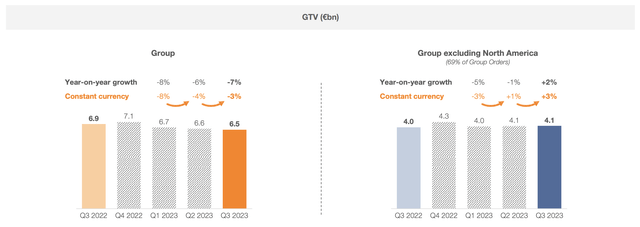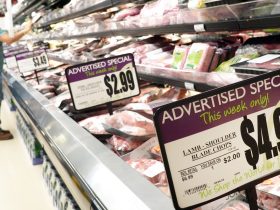Investment thesis
I maintain my buy rating on Just Eat Takeaway.com N.V. (OTCPK:JTKWY) following a Q3 trading update from the company.
The food delivery industry’s long-term outlook remains promising, driven by evolving consumer behaviors, the return of employees to offices, and projected growth in key markets. The European food delivery industry is anticipated to grow steadily, with the US market showing even more robust potential.
Yet, the company’s fundamental weaknesses persist, primarily driven by underperforming segments in the US and Southern Europe. Furthermore, the erosion of several key metrics, such as user numbers, indicates Just Eat Takeaway’s struggles to maintain its competitive position. This leaves doubts about the company’s ability to thrive in an increasingly competitive market.
Also, the underwhelming performance of its acquisitions, such as Grubhub, raises concerns. One potential bright spot is the prospect of shedding these underperforming operations, which could lead to a leaner and more focused business. While this might reduce the company’s total addressable market, it could create a more stable investment case and a sustainable business model.
However, there are uncertainties in the form of new regulations surrounding gig workers, which could impact food delivery platforms’ profitability and operational efficiency, including Just Eat Takeaway.
Looking forward, the company’s management has adjusted its near-term guidance to account for the uneven performance across regions, particularly the US and Southern Europe. While the profitability picture has improved slightly due to cost-efficiency measures and enhanced performance in certain regions, the long-term outlook remains uncertain. As a result, I maintain a cautious view of the company’s long-term prospects.
Nevertheless, the stock remains undervalued, even after adjusting estimates. A conservative valuation based on an EBITDA multiple suggests that shares continue to offer an attractive opportunity. Investors may potentially enjoy annual returns exceeding 30% based on the current share price and my price target.
Introduction – Shares down another 17%
I last covered Just Eat in August and rated the shares a buy. However, not because I was a big fan of the company. I can even say that my view of the company was quite negative, yet I rated shares a buy purely because my negative view was more than priced into the shares. So, while I did not view the company as long-term investment material back then (of course, this can always change), the significant undervaluation of the company, even based on my conservative expectations, left us with an excellent short to medium-term trade.
To be more precise, this is what I said a couple of months ago:
Looking at the company fundamentals and developments over the last couple of years, as well as its growth outlook, I would be urged to give the shares an avoid/sell rating as I believe there are better-positioned companies out there to benefit from the growth in the food delivery industry.
Yet, at the same time, the current share price and valuation, even based on a conservative sales growth and margin expansion outlook, looks rather attractive as a medium-term trade of around 2/3 years. The current valuation offers significant downside protection, even if growth comes in far below my current estimates. There is much value on the table here, and I believe that the current share price offers an attractive entry point for investors to benefit from.
And yet, while I could hardly see any more downside for the shares, these are down another 17% since August as the stock remains in its very own bear market, with shares down almost 50% YTD and over 20% over the last year. Just Eat shareholders can’t seem to be getting a break as shares continue to be impacted by negative news headlines and incredibly bad sentiment.
However, bad sentiment allows for those rare opportunities in the stock market through which investors can make impressive gains. As long as the underlying business remains unchanged and the market outlook is strong, investors have little to worry about.
In this case, the underlying business is even showing improvements, as highlighted by the company’s recently announced Q3 results, which I will focus on in this article.
Meanwhile, the food delivery market outlook remains strong, and while the industry has been struggling for traction coming out of the COVID-19 pandemic, it has shown resilience to above expectations, even when facing a deteriorating macroeconomic environment and increasingly challenging operating environment due to decreasing consumer spending power. However, indirectly, this could benefit the industry as consumers are less likely to eat out and with supermarkets also forced to hike prices, ordering in is often the most cost-effective opportunity.
Further helping the food delivery industry is the trend of employees returning to the offices. This results in people having less time to cook, increasing demand for delivery services. With 90% of companies saying they’ll return to the office by the end of 2024, this is a tailwind for the delivery industry as well.
Overall, the growth of the food delivery industry should accelerate over the next couple of years again, and focusing on the critical markets for Just Eat, the European food delivery industry is expected to grow at a CAGR of 12.3% through 2027, according to data from Statista. In addition, the US food delivery market, in which Just Eat remains active through Grubhub, is expected to grow even faster at a CAGR of 15.1% through 2027. This growth should benefit Just Eat in time.

European food delivery industry growth (Statista)
Weak fundamentals result in a mixed third-quarter performance
Looking at the company’s recent performance, there is more room for optimism as management delivered growth above expectations.
Gross transaction volume, the most important metric of growth for Just Eat, turned positive again in Q3, up 3% YoY, when excluding the struggling North American business (total GTV was still down 7% YoY). This was driven by a strong performance in the company’s key regions, Northern Europe, and the UK and Ireland, which saw GTV increase by 6% and 4%, respectively. Of course, this growth is still far from impressive, but in a challenging operating environment, we need to appreciate every bit of good news.

Just Eat Takeaway
These two segments account for around 55% of total GTV and mark the company’s key regions as this is where it is most prominent with leading market shares. For example, the company holds a demanding 45% market share in the UK, the largest European food delivery market, while also leading markets like Germany and the Netherlands. At the same time, Just Eat did report a strong increase in restaurant offering in the UK and Ireland with this up 16% YoY to 85,000, which increases its attractiveness to consumers.
Just Eat is seeing a solid recovery in these regions following the post-COVID-19 drop and has slowly been returning to growth in its key regions, accelerating growth from 0% and -6% back in Q1.
However, this is still below many of its peers, and on top of this, the company continues to report negative order growth, even in Northern Europe and the UK and Ireland, with total orders still down 7% in Q3. While this is an improvement from the negative 14% reported in Q1, these negative order numbers remain a negative indicator of user and activity growth.

Q3 data (Just Eat Takeaway)
Furthermore, with peers growing orders at the same time, this indicates to me that Just Eat is losing market share in its most crucial, largest, fastest growing, and most profitable regions. This is what I wrote previously:
Still, this GTV decline reported by Just Eat stands in sharp contrast with competitors such as Deliveroo, Delivery Hero (DHERO), and Uber, who all reported positive gross booking growth of 3%, 8%, and 12%.
With the industry health improving, these competitors will most likely also report a growth acceleration, which means Just Eat remains on the back foot compared to its primary competitors and loses market share. Even when excluding the underperforming segments and focusing on its key European regions, the company’s GTV growth sits below that of its peers.
Holding on to its market share is crucial to benefit from the industry growth in the future, and every percentage of market share lost is a loss in revenue potential, also when it comes to new delivery verticals like groceries, impacting its long-term potential.
Now, as earlier indicated, it’s the US and Southern Europe segments that continue to weigh on both top-line growth and profitability. In my previous article, I made my case for the company to spin off, sell, or discontinue these underperforming operations. In Q3, these two regions were once again disappointing as they reported a GTV decrease of 18% and 17% and didn’t show a performance improvement as they reported these same rate declines in Q1. Furthermore, these segments also continue to be loss-making.
And it’s not just this quarter or this fiscal year that these regions are underperforming, but Just Eat has consistently been unable to get these operations working, resulting in a failing international expansion strategy and the business as a whole deteriorating.
Just Eat acquired Grubhub (its US operations), its largest segment, in 2020 for €6.4 billion, but the business has since done nothing else than disappoint. The business is facing tough competition in the US food delivery market and has shown to be unable to really compete as its market share has fallen from 18% at the time of the acquisition to below 10% today.

Bloomberg second measure
It is no secret that Just Eat has been trying to find a buyer for its US operations recently, but the company has not been able to get rid of the business so far. Furthermore, it will likely need to sell the business for no more than €2 billion, making it a horrendous investment.
Management has indicated that it is not in a rush to sell the business as it is rapidly becoming profitable, potentially bringing up the valuation. Still, I hope it gets rid of it as quickly as possible and for management to do the same with the Southern Europe operations to streamline the business and focus resources on its most promising markets.
While this would limit the company’s TAM, such a move of streamlining the business could create more stability, an improved investment case, and a more sustainable business model as the company has already reached a 5% EBITDA margin in Northern Europe. I, therefore, believe it is important for investors to keep a close eye on this as the sale of these operations could meaningfully improve the investment case. Furthermore, the prospect of at least the US operations being sold could be a reason for investors to take the pain today and eye those future returns.
Just Eat launched a new €150 million buyback
Management launched a new €150 million buyback program, and just like the last one, I am not sure if this is the best way for management to deploy capital. Yes, shares are clearly massively undervalued. From that perspective, it makes a lot of sense as it allows the company to repurchase around 6% of its outstanding shares, massively benefitting its shareholders after it bought back 4.5% in the first half of the year.
However, while this might seem very lucrative to investors, I highly doubt this is the best way management can use its capital, especially as it is losing market share in key regions in Northern Europe. As a long-term investor, I would much prefer the company to invest these millions in improving its business by, for example, improving its apps and platforms, adding more restaurants to the platform, offering discounts to acquire more users, etc.
These actions make me doubt management’s ability to steer this company in the right direction for long-term sustainable growth and market share gains, further lowering my long-term faith in this company. Luckily, management can afford to spend this money on buybacks today as the company currently holds €2.2 billion in cash and has a strong overall balance sheet.
Still, I am not a fan.
New rules and laws regarding gig workers pose a significant threat to the delivery business model
While the company is already struggling operationally, it is also facing significant threats from the outside that are out of its control, as I am referring to new rules and regulations regarding gig workers. The likes of Uber (UBER) and Grubhub recently lost in an effort to block a minimum delivery pay rule in New York City, which would force companies to pay couriers an hourly rate of $17.96 or pay per delivery at about 50 cents a minute.
This is compared to a 2022 average hourly pay of around $15.84, a rate which, of course, highly fluctuates. The new rule would, therefore, increase the average hourly wage for drivers by over 13%, massively impacting either their profitability or the number of orders if these increases are pushed onto users. Of course, this also brings with it many operational problems.
Uber, DoorDash (DASH), and Grubhub are facing similar regulations in multiple regions and cities as governments are looking to create improved earnings certainty for these independent workers, creating a significant risk for these food delivery platforms, including Just Eat.
Furthermore, the EU aims to introduce a new law, which aims to improve economic conditions for gig workers, which would force Just Eat to reclassify their couriers, giving them full working rights. Uber executives have already released a statement against this new regulation, claiming it would force the company to shut down operations in hundreds of cities and raise prices by as much as 40% while also massively decreasing driver availability in major cities. According to Uber, it would practically destroy the operating model of delivery platforms. While I believe Uber might be overreacting here, the impact will undoubtedly be massive for Uber and Just Eat, massively eating into their profitability. Furthermore, it would complicate their operations and decrease role availability as drivers must be officially hired, not just sign up.
Whether these regulations will be passed remains to be seen, but it certainly massively increases the risk profile of any investment in Just Eat as the company is already barely able to report a profit. Any setback here could be detrimental, so keeping a close eye on any developments here is important.
Outlook and stock valuation
As GTV growth in primarily the US but also Southern Europe continues to disappoint and weigh on the overall business performance, management has lowered its FY23 GTV guidance as it now expects this to be down 4%, down from a previous guidance of -4% to +2% (constant currency). On constant currency, YTD GTV is down 5%, indicating management expects a further improvement in Q4, most likely fueled by Northern Europe and the UK and Ireland segments and coming in at -2%.
Furthermore, the Northern Europe and the UK and Ireland segments do remain highly profitable while being the fastest growing ones, positively impacting the company’s bottom line growth. At the same time, while Grubhub continues to struggle in terms of growth, the business is rapidly becoming cash flow neutral and with its significant weighing on the Just Eat business as a whole, the impact on the bottom line is substantial.
This, in combination with management’s cost-efficiency efforts, has allowed it to upgrade its FY23 profitability guidance as it now expects an EBITDA of €310 million, up from a previous €275 million. FCF guidance has also been revised upward as management now expects to report a break-even FCF in H2 of this year, turning positive in the first half of FY24, an improvement from the previous expectation of this to turn positive in H2 of FY24.
Finally, Just Eat management left its long-term financial targets unchanged, and while recent results allow me to upgrade my short-term outlook, I remain of the belief that management is too optimistic with its long-term targets.
The company has seen almost all metrics deteriorate in recent years, indicating that it is struggling to maintain its market position. For example, the number of users on the Just Eat platform declined 6% YoY in 2022 and another 7% in the first half of 2023. This has made me somewhat skeptical of its medium to long-term outlook and its ability to remain an industry leader. The company’s expansion strategy, notably its acquisition of Grubhub in the US, has not borne fruit as anticipated, and despite fast profitability improvements, future growth prospects remain uncertain as I am not convinced that Just Eat will be able to benefit from the expected industry growth due to the company’s seeming inability to tackle competition threats.
As a result, I am still expecting below-industry growth in the medium term, and there is no easy way to achieve substantial profitability here without significant operational adjustments. This vision, expectations, and management’s revised outlook now result in the following financial projections, reflecting the lowered FY23 GTV outlook (down €1 billion from previous estimates) and increased EBITDA guidance. Furthermore, these new estimates also reflect my expectations for lower-than-expected GTV growth in the medium term and slightly lower profitability expectations due to higher investments in FY24 and FY25.
(Note that the EBITDA margins could easily surpass 5% by FY24 if the US operations are sold.)

Financial projections (Author)
In terms of valuation, not much has changed since my previous article as I continue to view Just Eat as an investment with an above-average risk profile and believe it is far less favorably positioned compared to peers Uber and DoorDash. This is what I wrote previously:
I believe a conservative EBITDA multiple of 7x, which sits below the European stock market average of 12x and its peer average of 9/10x, rightfully accounts for the company’s recent struggles, possible market share losses, and its somewhat unpredictable outlook due to possible region exits.
Based on my lowered FY25 AEBITDA outlook and a 7x multiple, I now calculate a target price of €21 per share (down from €27). This shows that shares remain attractively valued despite my lowered outlook and very conservative estimates. Based on my price target and current share price of €11.50, investors could be poised for annual returns exceeding 30%.
Therefore, my investment thesis remains unchanged. I continue to view Just Eat as a weak long-term investment in terms of operational risks, growth potential, and profitability development. I currently see no clear way for the company to report a net profit, or at least not in its current format. The only way this could change is by getting rid of the underperforming assets. In that case, we could look at a solid company in the Northern European and UK delivery markets.
Nevertheless, I continue to rate shares a buy today as a result of its significant undervaluation. With investors poised for over 30% annual returns, I believe Just Eat takeaway continues to present a very compelling short to medium-term trade.
Until there are any fundamental changes, I recommend buying Just Eat Takeaway shares and waiting for the sentiment toward these shares to improve.
Editor’s Note: This article discusses one or more securities that do not trade on a major U.S. exchange. Please be aware of the risks associated with these stocks.
Read the full article here











Leave a Reply